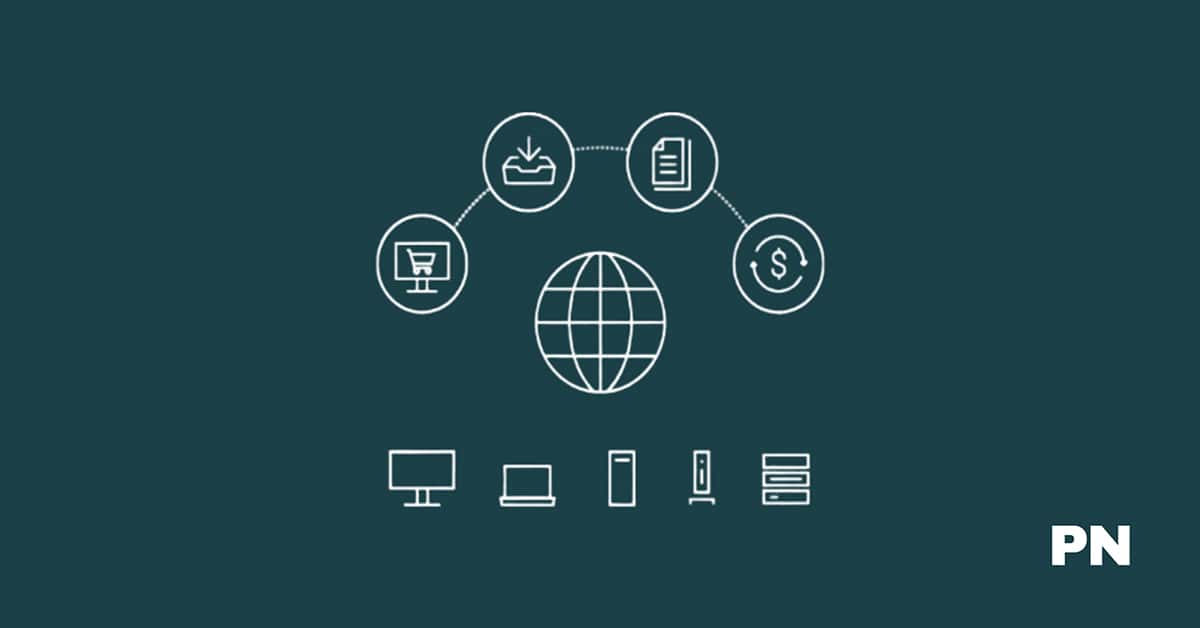39 Multichannel Marketing Statistics for Marketers

Multichannel marketing has transformed how businesses engage with their audience, offering a buffet of channels to capture consumer interest.
With 91% of retail brands using multiple social media channels, it’s clear that a varied approach can lead to improved customer retention and increased reach.
By engaging with consumers on their preferred platforms, companies are not just following a trend but capitalizing on a strategic imperative.
1. The multichannel marketing industry is expected to grow at a CAGR of 22.30% by 2030.
(Source: Market Research Future)
This growth signifies a bustling future for businesses that leverage multiple platforms to engage with consumers.
The multichannel marketing industry is expected to be worth $28.6 billion in 2030
From social media to email marketing, the diversification of channels allows a broader reach and the opportunity to connect with audiences in numerous, personalized ways.
Investing in multichannel strategies now can position you advantageously in an evolving marketplace. Your return on investment is likely to amplify as you grow alongside this industry uptrend.
2. Research has shown that multi-channel brands see a 7.5% annual decrease in cost per contact.
(Source: Shopify)
When you implement a multi-channel marketing strategy, you’ll likely notice a significant reduction in your cost per contact over time.
Here are key points on how this cost-effectiveness is achieved:
- Diversification: Utilizing multiple channels allows you to reach your audience where they prefer, which optimizes engagement and reduces wasted efforts.
- Integrated Data: By harnessing data from various channels, you gain insights that help you streamline your marketing messages, targeting the right audience with less effort.
- Synergy: Channels complement each other, making your overall strategy more effective, which can drive down the cost per interaction over time.
- Retention: A multi-channel approach can increase customer retention. It’s cheaper to keep a customer than acquire a new one, contributing to the drop in cost per contact.
Remember, while the initial setup of a multi-channel marketing strategy might require investment, efficiencies gained over time can lead to cost savings.
You clearly understand the cost benefits by continuously analyzing and optimizing your multi-channel efforts.
3. 70% of Shoppers Make Purchasing Decisions Entirely Online.
(Source: Display Mode)
The digital landscape has become the primary venue for your potential customers to evaluate and select products or services.
They often seek convenience, extensive variety, and competitive pricing—all of which can be effectively provided online.
Here’s a breakdown of the online decision-making process:
- Product Research: Shoppers often start their journey by gathering information from various online sources.
- Price Comparison: Customers compare prices across websites to ensure they get the best deal.
- Reviews and Ratings: Reading other customers’ experiences heavily influences the purchasing decision.
- Final Purchase: The actual transaction occurs on an e-commerce platform, which may include additional incentives like free shipping or discount codes.
Your multichannel marketing efforts should place significant emphasis on these digital touchpoints.
By fostering a seamless online experience, you’re aligning with the consumer’s preference to make empowered and informed purchase decisions from the comfort of their digital environment.
4. Two-thirds of shoppers use more than one channel.
(Source: Verde Group)
When you tailor your approach to meet customers on various platforms, you cater to a broad and dynamic shopping behavior landscape.
Consider these points in your strategy:
- Consistency across channels ensures a seamless experience.
- Integration allows for a cohesive journey, particularly for one-third who use multiple touchpoints.
- Personalization can be fine-tuned by channel, but should remain aware of cross-channel behaviors.
By acknowledging this multichannel norm, you position your business to meet consumers where they are, be it online, in-store, or through a catalog.
Understanding their habits informs your marketing mix and reinforces the customer experience.
5. Multichannel Marketing Market Size was valued at $5.69 billion in 2022.
(Source: iCrowdNewswire)
The market size is a testament to the existing multichannel strategies and indicates the potential for growth and investment in this area.
To give you a structured view of the 2022 market value:
- Traditional Media: Used to reach broad audiences through TV, radio, print
- Digital Channels: Included social media, email, SEO/SEM, mobile apps
- Investment Focus: Emphasis on tailoring customer experiences across channels
6. 95% of marketers know how vital multichannel marketing is for targeting, but only 73% say they have a multichannel strategy.
(Source: Invesp)
As a marketer, you must understand that multichannel marketing isn’t just about being present on multiple platforms.
It’s about creating a cohesive and strategic approach that engages your audience where they spend their time.
The discrepancy between recognition and execution points to potential roadblocks, such as budget constraints, complexity in integration, or a shortage of expertise.
Without a comprehensive multichannel strategy, you’re likely missing out on improved customer retention rates, heightened brand recognition, and increased ROI.
Developing and implementing a solid multichannel marketing strategy should be among your top priorities if you want to remain competitive and resonate with your audience on multiple fronts.
7. Multichannel TV ad revenue is forecasted to hit $44.79 billion by the end of 2025.
(Source: Statista)
In multichannel marketing, TV advertising continues to play a significant role.
Your strategy should acknowledge the significance of integrating TV into your multichannel approach. This recognizes the extensive reach of TV advertising and how it complements other digital channels to enhance overall campaign effectiveness.
In your planning, consider allocating resources that resonate with the enduring value of TV advertising, gearing your multichannel strategy for measurable success now and into the future.
8. 52% of marketers use 3 to 4 marketing channels, compared to 44% in 2015.
(Source: Postalytics)
Expanding your marketing channels can introduce complexities and allow you to engage with your audience through varied touchpoints.
Diversifying channels allows you to connect with more potential customers. Different channels enable customized messaging for specific audiences.
Multiple channels allow you to test strategies and see what works best for your brand.
Remember, every marketing channel operates differently.
The algorithm on Facebook is not the same as on Twitter, requiring a nuanced approach to each platform.
Adapting your strategy to work with each channel’s functionality and user behavior is essential for success.
As your strategies expand, focus on channels that contribute most to your sales and marketing goals.
Aligning your resources with the most productive channels will help optimize your campaign results.
9. 30% of marketers are highly confident in delivering a multichannel strategy.
(Source: Invesprco)
While this figure highlights a subset of marketers with a strong grasp of multichannel dynamics, it also underlines the complexity and challenges of managing campaigns across various platforms.
The multichannel environment continually evolves, and staying abreast of best practices requires continual learning and adaptation.
Your aim should be to join the ranks of these highly confident marketers. This is achieved through ongoing education, experimenting with new technologies, and measuring the impact of your multichannel campaigns.
Remember, a successful multichannel marketing strategy hinges on more than just confidence; it’s about proficiency, adaptability, and clarity in execution.
10. 51% of companies today use at least eight channels to interact with customers.
(Source: Sprout Social
Adopting a multi-channel strategy isn’t just a trend; it is essential for businesses aiming to maintain a competitive edge and provide comprehensive customer experiences.
The channels often deployed by companies include:
- Emails: for personalized communication and marketing campaigns.
- Social Media: to engage with you in an informal setting, where they can share updates and respond to feedback.
- Websites: that act as a central hub for product and company information.
- Phones: for direct communication and support.
- Live Chat: offering real-time assistance.
- In-store: providing physical interaction points for a tangible experience.
This strategy ensures that wherever customers interact with a brand, their experiences are consistent and seamless.
11. Customers who shop on multiple platforms have a 30% higher Customer Lifetime Value (CLV) than those who use a single channel.
(Source: CX Network)
If you’re a business aiming to nurture a loyal customer base, understanding the significance of a multichannel approach is critical.
CLV is the total revenue you can expect from a single customer over the entire period they do business with you.
Why is the CLV higher for multichannel customers?
Engagement: Multichannel customers interact more with your brand, which enhances their customer experience and increases their loyalty.
Convenience: Providing multiple platforms caters to varying customer preferences and needs, leading to a more satisfactory shopping experience.
Brand Cohesiveness: Consistent branding across all channels strengthens your brand image and cultivates trust.
Shoppers are likely to buy more frequently when they can access multiple channels.
12. Over 50% of multi-channel marketers have recorded an exceptional return on investment (ROI).
(Source: Invesprco)
If you are incorporating multiple channels in your marketing strategies, you might find it encouraging that multi-channel campaigns typically exceed the effectiveness of single-channel campaigns.
Engagement rates leap to 166% higher when two or more channels are used in a campaign than a single channel.
Your marketing approach with a multi-channel strategy should focus on:
- Segmentation: Tailoring your campaigns for different segments can substantially increase the ROI.
- Relevant channels: Choose channels most relevant to your audience to ensure higher engagement.
- Consistency: Maintain consistent messaging across platforms to build trust and recognition.
- Automation: Implement automation tools for more timely and effective communication.
Embrace these insights as you invest in multi-channel marketing to maximize your ROI and sustain a competitive edge.
13. 84% of Marketers Recognize that Multichannel Campaigns Are More Effective Than Single-Channel Campaigns.
Leverage more than one channel; you’re not just reaching out—you’re engaging.
Not putting all your eggs in one basket and adopting a multichannel strategy allows for a robust and flexible marketing paradigm.
14. Businesses using two or more channels in any single campaign experienced 166% higher engagement rates.
(Source: eConsultancy)
Combining these channels caters to different preferences within your audience, allowing you to connect in more personalized and effective ways.
For instance, while some customers respond more to email promotions, others may engage with your brand through social media or mobile notifications.
- Engagement Metrics:
- Click-through rates
- Social media interactions
- Conversion rates
- Time spent on the website
Incorporating multiple channels can elevate these metrics, significantly improving the overall effectiveness of your campaigns.
It’s important to monitor these engagement measures to understand the impact of your multichannel strategies and to make data-driven decisions for future campaigns.
Remember, higher engagement leads to better brand recognition, customer loyalty, and increased sales opportunities.
15. 62% of marketers say that implementing a multichannel strategy is a top priority for their organization.
(Source: Martech)
Multichannel marketing isn’t a mere trend but crucial for effectively reaching consumers.
Your marketing approach must integrate seamlessly across channels to stay relevant and competitive.
As a marketer, you must align with consumer expectations for flexibility and convenience, which a multichannel strategy provides.
Each touchpoint offers a unique opportunity to connect with and engage your customer base, fostering loyalty and driving growth.
16. 91% of consumers say they are more likely to purchase from brands that recognize them and provide relevant offers.
(Source: Accenture)
This significant percentage underscores the necessity of a marketing strategy that leverages consumer data to deliver customized experiences.
When you interact with a brand that remembers your preferences and past interactions, the engagement feels more intuitive and less like a generic sales pitch.
Incorporating these personal touches into your multichannel strategy means acknowledging the power of connection.
Your customers want to feel special and valued, not just another entry in a database.
The right mix of recognition and personalization fosters loyalty, and this loyalty translates into increased revenue.
Remember, relevance is key. Consumers expect not just any offers but ones pertinent to their needs and preferences.
Brands that accomplish this create a seamless and satisfying customer experience across all channels, from in-store to online platforms.
This level of personal engagement is a decisive factor for consumers when they decide where to spend their money.
17. 63% of consumers expect personalization as a standard of service and believe it’s crucial for a good experience.
(Source: Businesswire)
A consumer’s experience is often defined by the level of personalization you receive.
This expectation spans different sectors and is not confined to any industry.
You might notice personalized recommendations online or receive targeted offers based on your purchase history as a shopper.
Businesses that leverage consumer data to personalize experiences are not just meeting a preference—they are addressing a growing demand.
You should be aware of the dual edge of personalization; while it can greatly enhance your experience, there is a fine line between personalization and “creepy” tactics.
More than 50% of consumers have reacted negatively to what they perceive as invasive marketing strategies.
As part of the multichannel marketing landscape, businesses will likely invest further in personalization efforts. They are trying to build solid customer relationships and create a seamless experience across all channels.
As a result, companies that excel in personalization might see a significant portion of their revenue driven by these efforts.
18. 59% of customers say they feel frustrated when their expectations aren’t met during the shopping experience.
When you shop online or in a physical store, your expectations set the tone for your satisfaction.
You are likelier to remain loyal and engaged with a brand that consistently meets or exceeds your shopping expectations.
As a result, businesses are incentivized to closely monitor and adapt their marketing strategies to better cater to your needs and minimize frustration.
19. 73% of people prefer to shop via more than one channel. Customers enjoy having several marketing options.
(Source: HBR)
This multichannel approach offers flexibility and convenience. You can browse in a physical store, check prices on a smartphone app, or purchase through a desktop website.
You might notice that retailers are meeting these preferences by integrating multiple channels into their marketing strategies, leading to a seamless shopping experience.
Your shopping habits and preferences reshape how retailers approach sales and marketing, leading to a world where the multichannel experience is appreciated and expected.
Remember, as a consumer, your multichannel shopping behavior also contributes to increased retailer customer retention, demonstrating high value in a competitive market.
Your engagement across different platforms strongly indicates the success of the omnichannel strategy.
20. 66% of consumers would quit a brand if their experience isn’t personalized, rising to 75% among the Gen Z audience.
(Source: Quad)
Personalization is not a one-size-fits-all approach. It’s a commitment by brands to understand and cater to your unique characteristics.
This effort resonates strongly with you, especially if you are the younger, tech-savvy generation that values relevance and individual attention.
To sustain loyalty from customers like you, brands must integrate personalization into their core strategy—not merely as an add-on service.
21. Around 40% of Shoppers Start Their Buying Journey with a Broad Search Before Narrowing Down to Selected Channels.
When you begin your shopping journey, you often start with a broad search to explore a wide range of products and brands before honing in on specific ones.
What does this mean for you as a retailer?
It means you should be flexible. Recognize the importance of being present across various platforms since your potential customers use multiple touchpoints.
Also, ensure that your SEO strategies are robust, as a broad search typically starts with search engines.
Remember to track your interactions across all channels to understand and cater to how your audience prefers to shop.
Acknowledging that a significant portion of your potential customer base starts with a broad search can help you develop a more effective multichannel marketing strategy tailored to their shopping behaviors.
22. 85% of digital consumers begin purchasing on one device and finish on another.
(Source: Kinsta)
As you navigate the ever-evolving digital marketplace, it’s essential to understand how consumer habits are shaping e-commerce trends.
This behavior underscores the importance of a seamless, omnichannel approach that addresses customers’ needs across multiple platforms.
It’s not just about having a mobile-friendly website or an app.
Rather, it’s about creating a cohesive journey for consumers who might begin looking at a product on their smartphones but switch to laptops or tablets to complete the purchase.
Enhancing user experiences across multiple devices isn’t an option—meeting these consumer expectations is necessary.
By adapting to this, you meet your customers where they are and facilitate a smoother purchase path, potentially increasing conversion rates and building customer loyalty.
23. 71% of Shoppers Use Their Phones for In-Store Research, Highlighting the Importance of Informational Content for Purchasing Decisions.
(Source: Think with Google)
Your shopping behavior is increasingly influenced by the digital content you encounter.
When navigating aisles, the type and quality of informational content you access can make or break your buying choices.
Here are key aspects of this behavior:
Price Comparisons: Easily, the most common use of in-store mobile research is comparing prices to ensure you’re getting the best deal possible.
Product Reviews: You often look for reviews from other consumers to gauge the quality and suitability of a product before committing.
Product Descriptions: Detailed information about product features, benefits, and specifications is crucial to you. It helps you understand whether a product meets your needs.
Businesses need to optimize their online presence across all platforms. As a marketer, ensuring your website or app has comprehensive product information can significantly influence in-store sales.
24. 86% of Shoppers Switch Across at Least Two Marketing Channels Before Making Significant Purchases.
(Source: PWC)
When you channel-hop, you’re likely seeking a variety of touchpoints —such as ads, reviews, and price comparisons—to gain a comprehensive understanding of the product. For instance:
- You might see a product on a social media ad,
- Then, search for reviews on a separate review platform,
- Finally, check the prices on the brand’s website before deciding.
As a seller, recognizing this pattern is crucial for developing an effective multichannel marketing strategy.
Remember, the quality of the experience across these channels can influence your decision to purchase.
Therefore, a seamless and consistent presence across multiple channels is indispensable for brands aiming to capture your attention and business.
25. Brands that engage customers using omnichannel approaches are predicted to see a 9.5% yearly revenue boost compared to those with weak omnichannel strategies.
(Source: Glia)
The statistics underscore the importance of a cohesive experience across all customer touchpoints, in-store, online, or via social media platforms.
This level of consistency in messaging and customer experience paves the way for increased satisfaction and loyalty, which can boost your sales.
Remember, in retail and marketing, customer experience is paramount.
A comprehensive omnichannel strategy can lower costs per contact over time.
By making omnichannel a priority, you stand to gain not only immediate revenue but also long-term customer relationships and brand value.
26. Facebook is the most popular social platform for marketers to broadcast videos (75%), followed by YouTube (70%) and Instagram (58%).
This high percentage underscores Facebook’s stronghold as a top channel for your video marketing strategies. Its vast user base and sophisticated targeting options make it an attractive platform.
YouTube is a dedicated video platform known for its expansive reach and longevity of content.
Thanks to YouTube’s strong search capabilities, your videos can continue to garner views long after posting.
Instagram isn’t far behind.
Although Instagram is primarily image-focused, its features, such as Stories, IGTV, and Reels, offer diverse formats for presenting video content in shorter, more engaging bursts.
Below is the marketer’s usage percentage of social platforms for broadcasting videos:
These statistics suggest that while Facebook leads, YouTube and Instagram also play significant roles in a multichannel video marketing strategy.
So, as you craft your video marketing campaigns, consider these platforms’ unique attributes and audience preferences to maximize your reach and engagement.
27. Campaigns that combine at least four digital marketing channels are more likely to outperform those using only one or two.
(Source: Lytics)
The number of channels you integrate into your campaigns significantly influences your success in the digital marketing landscape.
By incorporating multiple channels, you can reach your audience where they are most active.
Whether it’s social media, email, paid ads, or content marketing, each platform offers unique benefits and caters to different segments of your customer base.
With a multichannel approach, you enhance the customer experience by providing multiple touchpoints. This also gives you robust data to understand the customer journey better.
28. Data accuracy is the most crucial component in measuring the performance of a multichannel marketing campaign.
(Source: Ascend2)
Accurate data is the cornerstone of successfully evaluating your multichannel marketing efforts.
When you’re active across various platforms, each channel generates valuable data that shows your strategy’s performance.
Key areas where data accuracy impacts your multichannel marketing measurement:
- Tracking User Interaction: You need precise data to understand how customers interact with your campaigns across different channels.
- Attribution Modeling: Correctly attributing sales and conversions to the right channel relies on the integrity of your data.
- Budget Allocation: Your decision on where to invest resources for the highest ROI hinges on the accuracy of the performance data.
To maintain data accuracy, consider these steps:
- Implement Rigorous Data Collection Standards: Ensure all channels follow uniform data entry methods.
- Regularly Audit Your Data: Conduct periodic checks to catch and correct inaccuracies.
- Utilize Reliable Analytics Tools: Use trusted software to analyze your marketing data effectively.
Inaccuracy can lead to misinformed decisions, potentially wasting budget and resources on underperforming channels.
By prioritizing data accuracy, you will be equipped with the confidence to make informed strategic decisions and maximize the impact of your multichannel marketing campaigns.
29. Email Subscribers are 3.9 Times More Likely to Promote Your Content on Social Media Than Search Engine Visitors.
(Source: Search Engine Journal)
Statistically, email subscribers are significantly more likely to share content they receive on social media platforms.
Emails create a direct line of communication with you. This personalized interaction fosters a stronger connection, making you more inclined to support and share the content.
It’s important to recognize the power you hold as an email subscriber.
Ensuring the content you receive is share-worthy means that brands must invest in high-quality, engaging, and relevant email marketing strategies to tap into your potential as a promoter on social media.
30. Almost 46% of marketers use Google Shopping and Facebook simultaneously.
As you navigate the terrain of multichannel marketing, it’s important to recognize the synergy between Google Shopping and Facebook.
Google Shopping provides an on-the-spot, searchable catalog of products, allowing your potential customers to make quick purchase decisions.
It’s integrated directly into the Google search engine, providing seamless shopping experiences.
In contrast, Facebook offers a more dynamic, engaging platform on which to build a narrative around your products.
By combining these platforms, you can benefit from users’ direct shopping intent on Google and the deeper engagement and targeting capabilities on Facebook.
31. Email Marketing is the Most Popular Marketing Channel, with 81% of B2B Marketers Opting for Email Newsletters.
(Source: Content Marketing Institute)
Email marketing continues to be a cornerstone in the toolbox of B2B marketers.
Efficiency and Reach: Email provides a direct line of communication to your target demographic, allowing for personalized content that drives engagement and, ultimately, conversions.
High ROI: The return on investment (ROI) for email marketing is exceptionally strong. Figures point towards an impressive ROI of 42:1, which emphasizes the cost-effectiveness of this marketing strategy.
Personalization and Segmentation: One reason email marketing is so prevalent is its capacity for personalization. You can segment your audience and tailor content to meet the needs of different groups, making your email newsletters more relevant and compelling.
Conversion Rates: The average email conversion rate is 6.05%. This indicates that emails are being opened and read and effectively prompting recipients to take action.
Focusing on email newsletters is a strategic decision for a marketer, backed by their substantial use and success rates within the B2B sphere.
When executed with precision, email marketing can help cultivate relationships, build brand awareness, and generate leads, contributing to the sustainability and growth of your business.
32. 99% of email users check their emails at least once daily.
(Source: OptinMonster)
With such a high percentage of daily engagement, your email strategy can be optimized by considering when and how often you send out your marketing communications.
It’s clear that email marketing maintains its stature as an essential tool for effectively reaching out to and engaging with a broad audience.
Emails are more than just messages; they’re a touchpoint for customer interaction, brand awareness, and maintaining an ongoing relationship with your audience.
33. In the last year, 55% of B2B buyers have increasingly relied on content to research and make purchasing decisions.
(Source: Demand Gen Report)
As a B2B buyer, you may find that content becomes a pivotal tool when performing research and guiding your purchasing decisions.
When it comes to seeking information on potential vendors and products, consider leveraging various content formats:
- Whitepapers: for detailed insights and analysis
- Case Studies: to understand real-world applications and results
- Blog Posts: for current trends and thought leadership
- Product Demos and Videos: for a visual and practical demonstration of offerings
By embracing content as a research tool in your decision-making process, you find value in the comprehensive insights that high-quality content provides.
34. Approximately 60% of agencies and brands consider content marketing “very significant” in their marketing plans.
(Source: ZoomInfo)
This emphasis directly responds to consumer behavior, which shows a preference for value-driven, informative content over traditional advertisements.
These formats provide your audience with substance and encourage meaningful engagement.
This prioritization indicates a shift where trust and authority are paramount.
Content marketing doesn’t just aim to sell; it seeks to create a relationship with the consumer.
By delivering consistent and valuable information, brands and agencies leverage content to establish thought leadership within their industry.
Content can be repurposed across multiple platforms, giving your message a broader reach. Additionally, quality content continues to attract traffic and leads long after its initial publication, which can reduce overall marketing costs.
Remember, your content is a tool for sales and fostering lasting relationships with your audience.
35. Companies who use a multi-channel marketing approach enjoy up to 91% greater annual customer retention rates.
(Source: Loyalty360)
Multi-channel marketing involves engaging with customers through a combination of direct and indirect communication channels, such as social media, email, retail, and more.
This strategy lets you meet your customers where they are, offering them a seamless experience across platforms.
Your customers expect consistency. When they interact with your brand across various channels, they want a unified message and experience.
By providing this consistency, you’re not just meeting their expectations but enhancing their brand loyalty.
This is reflected in retention rates: businesses that adeptly manage multi-channel marketing retain significantly more customers than those that don’t.
36. Not using an omnichannel approach could mean missing out on approximately 10% of potential revenue.
An omnichannel strategy integrates multiple channels to provide a seamless customer experience.
Buyers anticipate a fluid experience across all platforms. If their expectations are unmet, they may take their business elsewhere.
Without omnichannel, you might miss vital engagement opportunities leading directly to conversions.
Ensure your marketing strategy includes a responsive and consistent brand experience across all channels.
Integrating your efforts can be challenging but may lead to significant rewards in retaining and growing your customer base and, subsequently, your revenue.
37. In 2023, online retailers employed an average of 2.7 paid channels, down from 3.2 mediums in 2022.
(Source: Ruler Analytics)
Possible factors influencing the reduction:
- Budget reallocation: You may have been streamlining your marketing budget, focusing on channels delivering the best ROI.
- Channel effectiveness: Discovering which channels perform best for your industry could have influenced a more targeted approach.
- Market saturation: Perhaps certain paid channels became oversaturated, leading to diminishing returns and a strategy recalibration.
Considering these insights, you can reflect on your marketing strategies and how they align with current trends.
Keep an eye on your channel performance to ensure your marketing efforts are cost-efficient and effective.
38. Existing customers spend 31% more than recently acquired ones.
(Source: Forbes)
When you analyze customer spending habits, you’ll notice a significant difference between the expenditures of loyal, existing customers and those of newly acquired ones.
Understanding this spending pattern can shape your marketing strategies.
By focusing on customer retention programs, you can tap into the higher spending propensity of loyal consumers. Consider the following points:
Customer Familiarity: Repeat customers are more familiar with your product range, building trust and increasing their likelihood of purchasing more expensive items.
Increased Confidence: Having previous satisfactory experiences, existing customers feel confident about spending more on subsequent purchases.
Targeted Recommendations: You can use purchase history data to target existing customers with personalized product recommendations, thus boosting their average spend.
Rewards and Loyalty Programs: Implementing rewards for repeat purchases can incentivize existing customers to spend more to reach different reward tiers.
Enhance your marketing efforts by aligning them with customer spending behaviors.
Investing in your existing customer base can yield higher returns and contribute substantially to your long-term business growth.
39. 50% of multi-channel marketers say they “usually” or “always” hit their financial targets.
(Source: Invesp)
When you leverage multiple marketing channels, you align with a strategic approach that significantly increases your chances of meeting financial goals. This is because giving customers a more streamlined experience drives sales.
Remember, the effectiveness of your marketing campaigns may depend significantly on how well you integrate and manage multiple channels.
Frequently Asked Questions
How effective is multi-channel marketing?
Multichannel marketing is highly effective, with reports suggesting that 72% of consumers prefer to connect with brands through multiple channels. Taking note of this preference, retail brands are implementing strategies that span several platforms to engage their audience.
What is the multichannel marketing theory?
The multichannel marketing theory says that providing customers with a seamless shopping experience across various online and offline channels optimizes engagement and conversion rates.
What are the three keys to success for multichannel marketing?
The three keys to success in multichannel marketing are 1) understanding and meeting customer preferences for channel interaction, 2) maintaining a consistent brand message across channels, and 3) using data analytics to drive strategic decisions and personalize the customer experience.
Which is recommended for effective use of multichannel marketing?
A clear strategy is recommended for effective multichannel marketing. This strategy entails choosing the right mix of channels based on where customers are most active.
What role does technology play in optimizing multichannel marketing efforts?
Technology is essential in optimizing multichannel marketing efforts. It enables the integration of various marketing tools and platforms. It facilitates data collection and analysis, customer segmentation, and personalized content delivery, key components for a successful multichannel strategy.
Final Thoughts on Multichannel Marketing Statistics
The data surrounding multichannel marketing underscores its critical role in today’s digital ecosystem. It’s not just about spreading your message across platforms; it’s about optimizing communication to align with customer preferences.
Remember, the aim is to create a seamless experience for your customers that reflects their individual preferences and respects their time and attention.
A comprehensive multichannel strategy doesn’t dilute your brand’s message but amplifies it, ensuring that you meet your customers where they are, figuratively and literally.
Disclosure: We may earn commissions if you buy via links on our website. Commissions don’t affect our opinions or evaluations. We’re also an independent affiliate of many platforms, including ClickFunnels, Kartra, GoHighLevel, Podia, Northwest Registered Agent, and others. We’re not employees of these services. We receive referral payments from them, and the opinions expressed here are our own and are not official statements of these companies.





